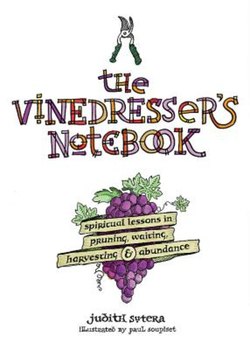Читать книгу The Vinedresser's Notebook - Judith Sutera - Страница 7
На сайте Литреса книга снята с продажи.
ОглавлениеIT TAKES A LONG TIME TO GET OLD AND thick and gnarled. In the process, many things happen and each event leaves its mark. Some of what we see is a result of growth; some is damage. This external appearance is only part of the story that the plant or the person carries. With trees, there are growth rings that can only be seen when the plant is laid open and examined in cross section. The growth rings make up a living record of each year’s ups and downs: cold, heat, drought, injury. In some way, the new shoots carry those effects as well. If there have been too many dry years or wet years or hard-weather years, it will affect the growth for years to come. Damage to an area may mean no shoots there for a long time or perhaps ever.
Like trees, people are marked by the formative events in their lives too. When we meet someone, we encounter what that person has become as a result of all that has come before. We can’t see the growth rings inside, see how they mark the rich and the lean years, or know what each season did to him or her.
Sometimes with people, as with a vine, we can see the scars where something has been cut off, where there has been a pruning. All we can see, however, is the scar. We don’t know how they were damaged or what the missing parts looked like or why they had to be cut away. Fears and insecurities, losses and pain, and the behaviors that do not serve us well—all of these are signs of our past wounds.
Such wounds become permanent parts of us, and they may become the most obvious things about us. The plants in our vineyard are old and thus have very weathered trunks with many stumps. I cannot know what nourished them, how many shoots they’ve had, or how much fruit has gone forth. I see them only as they are at this time, and thus I have a very incomplete picture. Some plants, perhaps, were once vigorous and productive but have diminished. Other plants may look strong, but I have no idea whether they have actually borne much fruit. Some may have weathered extraordinary difficulties.
As a Benedictine, I am instructed by St. Benedict’s rule to “welcome everyone as Christ.” Since we see such a limited view of a person, that can be a very tall order. Appearances can be quite deceiving, so I have to assume that there is much more to a person than meets the eye. I have to assume, too, that the parts of you that I do not see have value and goodness and potential.
We had a sister who was a very demanding teacher, a stern personality rarely satisfied with others. Hers was not a warm personality; consequently, most people knew her only from their superficial interactions with her, and those were often strained. When she died, another sister made some remark that she would not grieve or miss her much. I asked her if she was aware of the sister’s background.
For whatever reasons, in her later years, that usually reserved sister had opened up to me, telling me stories about her childhood that were filled with pain. She had been harshly treated by the relatives who raised her after the loss of her own parents. Her aunt and uncle were demanding and punishing; nothing she did was ever good enough. As I told this story, the angry sister fell silent, then thanked me. On the day of the funeral there was bad weather, so only the sisters who were pallbearers or had other official functions went to the grave. I looked up to see the deceased’s “enemy” coming slowly down the cemetery road huddled under an umbrella.
“I’m so glad you could come,” I said.
Her reply: “I realized it’s never too late for a little conversion and forgiveness.”
We can never know how others got to be the way they are. We can only try to believe that they are doing the best they can with what they have. This is the filter that will enable us to see the glimmer of goodness and purity within them and treat them accordingly.
